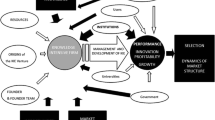Abstract
This book’s aim is to provide a fresh insight on the knowledge economy and its driving forces. The book has demonstrated that there is a widening discrepancy between the way mainstream economics understands the relationships between knowledge and creativity, and the step(s) a typical enterprise exposed to the global market is taking to deal with them. Whilst mainstream economics continues to cling firmly to a logical-positivist notion of knowledge, enterprise is experiencing a hermeneutic turn under the pressure to provide ceaseless innovation in an increasingly competitive market. From being the alleged champion of modernity, enterprise is, somewhat surprisingly, becoming the laboratory inside which this cognitive turn is finally entering the social fabric, after being long confined to the philosophical, aesthetical and literary debate. The time thus seems to have come to scrutinise the above-mentioned discrepancy: how it has arisen, what consequences follow in the theoretical and the applied domains, and on what conditions it can eventually be overcome. This is the rationale on which this book is based.
Access this chapter
Tax calculation will be finalised at checkout
Purchases are for personal use only
Similar content being viewed by others
Notes
- 1.
The neologism is drawn from Simon, (1956).
- 2.
With the exception of Garbolino, whose contribution was intentionally devoted to outlining a preliminary epistemological framework.
- 3.
The Munich case is not comparable, due to different criteria of collecting data.
- 4.
Where pòlis significantly means ‘many’ prior to ‘city’ and ‘politics’.
- 5.
An issue which is (or was?) not extraneous within the neo-Marxist debate (cf. Godelier, 1978), and which might interestingly be exposed to the interpretative turn.
- 6.
But limited to the first two of the elements mentioned below, as Cusinato has shown.
- 7.
The term ‘community’ means that there has to be a minimal common basis of shared values and also visions etc. among participants, so that it becomes in any case a matter of ‘related heterogeneity’. This expression clearly echoes the debate about the role of related and unrelated variety in economic development (Frenken, Van Oort, & Verburg, 2007).
- 8.
This is a quite different condition from the Schumpeterian “creative destruction”, which is based on an extremely thick and ordered relational structure, the market.
- 9.
References
Alonso, A. (1998). Urban Graffiti on the City Landscape. Paper presented at the Western Geography Graduate Conference, San Diego State University, February 14. Available at http://www.asu.edu/courses/aph294/total-readings/alonso%20--%20urbangraffiti.pdf.
Alonso, W. (1973). Urban zero population growth. Daedalus, 102(4), 191–206.
Andersson, Å. E. (2011a). Creative people need creative cities. In D. E. Andersson, Å. E. Andersson, & C. Mellander (Eds.), Handbook of creative cities (pp. 14–55). Cheltenham: Edward Elgar.
Andersson, D. E. (2011b). Creative cities need less government. In D. E. Andersson, Å. E. Andersson, & C. Mellander (Eds.), Handbook of creative cities (pp. 327–342). Cheltenham: Edward Elgar.
Carayannis, E. G., & Campbell, D. F. J. (2012). Mode 3 knowledge production in quadruple helix innovation systems: 21st-century democracy, innovation, and entrepreneurship for development. New York: Springer.
Compagnucci, F. & Cusinato, A. (2015). Il ruolo delle piccole e medie città nell’economia 3.0. Evidenze dal caso italiano, Scienze Regionali, forthcoming.
Dembski, S. (2013). In search of symbolic markers: transforming the urbanized landscape of the Rotterdam Rijnmond. International Journal of Urban and Regional Research, 37(6), 2014–2034.
Etzkowitz, H., & Leydesdorff, L. (2000). The dynamics of innovation: From national systems and “Mode 2” to a Triple Helix of University-Industry-Government relations. Research Policy, 29(2), 109–123.
Frenken, K., Van Oort, F., & Verburg, T. (2007). Related variety, unrelated variety and regional economic growth. Regional Studies, 41(5), 685–697.
Godelier, M. (1978). Infrastructures, societies, and history. Current Anthropology, 19(4), 763–771.
Hall, P. G. (1998). Cities in civilization: Culture, innovation, and urban order. London: Weidenfeld & Nicholson.
Healey, P. (2004). Creativity and urban governance. Policy Studies, 25(2), 87–102.
Heinen, H. (2013). Space as receptor, instrument or stage: Notes on the interaction between spatial and social constellations. International Planning Studies, 18(3–4), 342–357.
Huizinga, J. (1944). Homo Ludens: A study of the play-element in culture. New York: Routledge & Kegan Paul.
Kahn, A. Z., Moulaert, F. & Schreurs, J. (2013). Epistemology of space: Exploring relational perspectives in planning, urbanism, architecture. International Planning Studies, 18(3–4), 287–303.
Lachmann, R. (1988). Graffiti as career and ideology. American Journal of Sociology, 94(2), 229–250.
Landry, C. (2011). A roadmap for the creative city. In D. E. Andersson, Å. E. Andersson & C. Mellander (Eds.), Handbook of creative cities (pp. 517–536). Cheltenham: Edward Elgar.
Löw, M. (2008). The constitution of space: The structuration of spaces through the simultaneity of effect and perception. European Journal of Social Theory, 11(1), 25–49.
Löwe, A. (2013[1935]). Economics and Sociology. New York: Routledge.
Madanipour, A. (2013). Researching space, transgressing epistemic boundaries. International Planning Studies, 18(3–4), 372–388.
Moreau, T. & Alderman, D. H. (2011). Graffiti hurts and the eradication of alternative landascape expression. Geographical Review, 101(1), 106–124.
Moroni, S. (2011). Land-use regulation for the creative city. In D. E. Andersson, Å. E. Andersson, & C. Mellander (Eds.), Handbook of creative cities (pp. 343–364). Cheltenham: Edward Elgar.
Perrin, J.-C. (2006[1995]). Apprentissage collectif, territoire et milieu innovateur: Un nouveau paradigme pour le développement. In R. Camagni & D. Maillat (Eds.). Milieux innovateurs: Théorie et politiques. (pp. 99–128). Paris: Economica.
Simon, H. (1956). Rational choice and the structure of the environment. Psychological Review, 63(2), 129–138.
Swedberg, R. (1990). Economics and sociology: redefining their boundaries. Conversations with economists and sociologists. Princeton: Princeton University Press.
Waldheim, C. (Ed.) (2012). The landscape urbanism reader. New York: Princeton Architectural Press.
Author information
Authors and Affiliations
Corresponding author
Editor information
Editors and Affiliations
Rights and permissions
Copyright information
© 2016 Springer-Verlag Berlin Heidelberg
About this chapter
Cite this chapter
Cusinato, A., Philippopoulos-Mihalopoulos, A. (2016). Conclusions. In: Cusinato, A., Philippopoulos-Mihalopoulos, A. (eds) Knowledge-creating Milieus in Europe. Springer, Berlin, Heidelberg. https://doi.org/10.1007/978-3-642-45173-7_15
Download citation
DOI: https://doi.org/10.1007/978-3-642-45173-7_15
Publisher Name: Springer, Berlin, Heidelberg
Print ISBN: 978-3-642-45172-0
Online ISBN: 978-3-642-45173-7
eBook Packages: Economics and FinanceEconomics and Finance (R0)




